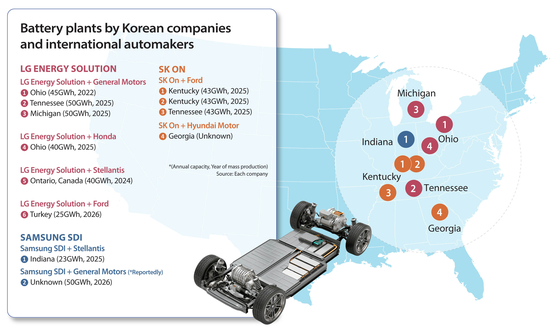[ANALYSIS] Exclusive carmaker-battery partnerships now a thing of the past
![Choi Yoon-ho, left, CEO of Samsung SDI, and Mark Stewart, COO at Stellantis North America, shake hands after signing an agreement to build a $2.5 billion battery factory in Indiana in May. [SAMSUNG SDI]](https://koreajoongangdaily.joins.com/data/photo/2023/03/11/4f621be7-8cfe-4c3b-a3e1-0caf5fb29cb7.jpg)
Choi Yoon-ho, left, CEO of Samsung SDI, and Mark Stewart, COO at Stellantis North America, shake hands after signing an agreement to build a $2.5 billion battery factory in Indiana in May. [SAMSUNG SDI]
In the electric vehicle industry, the partnerships between General Motors and LG Energy Solution and between Ford and SK On appeared so solid and long-standing that media outlets often called the relations an alliance.
But that may not be the case for much longer as manufacturers are on a quest to find new tactics and engage a diverse mix of battery suppliers to secure a stable supply chain and access to more battery options.
The recent reports of General Motors possibly building a joint battery plant with Samsung SDI clearly shows this change, as the Michigan-based automaker earlier scrapped its initial plan with LG Energy Solution, Korea’s largest battery manufacturer.
Since 2019, when General Motors and LG Energy formed a 50:50 Ultium Cells joint venture, the two have worked together on three battery plants, either running or still under construction, in Ohio, Tennessee and Michigan.

“The latest deal implies that General Motors now wants to use prismatic- and cylindrical-type batteries, and not just stick to pouch-type batteries,” said Chang Jung-hoon, a researcher from Samsung Securities.
“As demand for batteries surges, regardless of the type, it will be difficult for automakers to keep partnerships with any one single battery maker any longer."
LG Energy Solution produces pouch-type batteries at its three plants with General Motors. Samsung SDI makes prismatic- and cylindrical-type batteries.
"In the midst of the widening demand of automakers, Samsung SDI has various form factors including prismatic batteries, our major products, and cylindrical-type batteries," said Michael Son, senior vice president for Samsung SDI’s strategic marketing team, during a conference call in October.
Samsung SDI is also developing its own cylindrical batteries 46 millimeters in diameter. The height of the battery has not been decided yet.
![Samsung SDI's electric car batteries [SAMSUNG SDI]](https://koreajoongangdaily.joins.com/data/photo/2023/03/11/fffdf2be-3db7-4e58-8077-c638d5b9e1d5.jpg)
Samsung SDI's electric car batteries [SAMSUNG SDI]
Despite its advantage in safety, cylindrical-type batteries were initially shunned by some automakers due to their lower energy density and heavy weight.
But they have been steadily garnering attention since 2020 when Tesla introduced its “4680” cylindrical batteries, batteries that are 46 millimeters in diameter and 80 millimeters in height. They have some five times the energy density of existing batteries, reducing battery costs by 50 percent.
General Motors’s decision also comes as LG Energy has been expanding partnerships with other automakers.
The Wall Street Journal earlier in the year reported that “plans for a fourth GM-LG factory were scratched in part because LG Energy executives in Korea were hesitant to commit to the project given the rapid pace of LG’s recent U.S. investments.”
LG Energy Solution is also building a $5 billion battery plant in Ontario with Stellantis, a multinational automaker that is building another $2.6 billion battery plant with Samsung SDI.
"Unlike in the past, when General Motors and Ford had exclusive battery supply deals with LG Energy and SK On, it is now impossible for an individual cell maker to meet all of an automaker’s battery needs as their demand requirements are widening, as evidenced by the collapse of the Ford-SK On partnership in Europe and General Motors' decision to find a new cell supplier for its fourth North America plant," said Cho Hyun-ryul, a senior analyst at Samsung Securities.
LG Energy Solution recently disclosed its plans to build a battery plant in Turkey with Ford Motor and Istanbul-based Koc Holding.
![Kim Dong-myung, left, head of advanced automotive battery division at LG Energy Solution and Mary Barra, CEO of General Motors pose for a photo after making their investment plan in building a third battery plant in Lansing, Michigan. [LG ENERGY SOLUTION]](https://koreajoongangdaily.joins.com/data/photo/2023/03/11/69dee75c-19e4-4c0f-a396-7d113fdfc5de.jpg)
Kim Dong-myung, left, head of advanced automotive battery division at LG Energy Solution and Mary Barra, CEO of General Motors pose for a photo after making their investment plan in building a third battery plant in Lansing, Michigan. [LG ENERGY SOLUTION]
![SK Group Executive Vice Chairman Chey Jae-won, left, and Kentucky Governor Andy Beshear pose for a photo during a groundbreaking ceremony of their battery plant in Glendale, Kentucky, on Dec. 5. [SK On]](https://koreajoongangdaily.joins.com/data/photo/2023/03/11/8e3309da-4bef-4a4b-89ad-6204f4ee3c0c.jpg)
SK Group Executive Vice Chairman Chey Jae-won, left, and Kentucky Governor Andy Beshear pose for a photo during a groundbreaking ceremony of their battery plant in Glendale, Kentucky, on Dec. 5. [SK On]
Ford and SK have already established an $11.4-billion joint venture called BlueOval SK in the United States with an aim of building factories in Kentucky and Tennessee.
Hyundai Motor is already receiving batteries from all three battery makers.
“Top EV makers are diversifying battery sourcing in order to manage supply chain cost and risk,” read a recent Goldman Sachs report, mentioning Xiaopeng, whose battery dependency on CATL fell to 52 percent in 2022 from 79 percent a year earlier.
“Longer term, we believe sustainable EV supply growth would require a more diversified battery chemistry mix,” the report added.
There were around 10 million EVs on the road in 2021, and that will likely surge fivefold to 55 million in 2025, according to data from SNE Research.
The demand for EV batteries, which stood at 455 gigawatt hours worldwide last year, is estimated to skyrocket to 3,600 gigawatt hours during the same period.
BY SARAH CHEA [chea.sarah@joongang.co.kr]










with the Korea JoongAng Daily
To write comments, please log in to one of the accounts.
Standards Board Policy (0/250자)